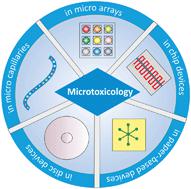Our official English website, www.x-mol.net, welcomes your feedback! (Note: you will need to create a separate account there.)
Microtoxicology by microfluidic instrumentation: a review
Lab on a Chip ( IF 6.1 ) Pub Date : 2022-06-01 , DOI: 10.1039/d2lc00268j Jialan Cao 1 , Charmi Chande 2 , J Michael Köhler 1
Lab on a Chip ( IF 6.1 ) Pub Date : 2022-06-01 , DOI: 10.1039/d2lc00268j Jialan Cao 1 , Charmi Chande 2 , J Michael Köhler 1
Affiliation

|
Microtoxicology is concerned with the toxic effects of small amounts of substances. This review paper discusses the application of small amounts of noxious substances for toxicological investigation in small volumes. The vigorous development of miniaturized methods in microfluidics over the last two decades involves chip-based devices, micro droplet-based procedures, and the use of micro-segmented flow for microtoxicological studies. The studies have shown that the microfluidic approach is particularly valuable for highly parallelized and combinatorial dose–response screenings. Accurate dosing and mixing of effector substances in large numbers of microcompartments supplies detailed data of dose–response functions by highly concentration-resolved assays and allows evaluation of stochastic responses in case of small separated cell ensembles and single cell experiments. The investigations demonstrate that very different biological targets can be studied using miniaturized approaches, among them bacteria, eukaryotic microorganisms, cell cultures from tissues of multicellular organisms, stem cells, and early embryonic states. Cultivation and effector exposure tests can be performed in small volumes over weeks and months, confirming that the microfluicial strategy is also applicable for slow-growing organisms. Here, the state of the art of miniaturized toxicology, particularly for studying antibiotic susceptibility, drug toxicity testing in the miniaturized system like organ-on-chip, environmental toxicology, and the characterization of combinatorial effects by two and multi-dimensional screenings, is discussed. Additionally, this review points out the practical limitations of the microtoxicology platform and discusses perspectives on future opportunities and challenges.
中文翻译:

微流控仪器的微毒理学:综述
微毒理学关注少量物质的毒性作用。这篇综述文章讨论了少量有毒物质在小体积毒理学研究中的应用。在过去的二十年中,微流体微型化方法的蓬勃发展涉及基于芯片的设备、基于微滴的程序以及使用微分段流进行微毒理学研究。研究表明,微流体方法对于高度并行化和组合的剂量反应筛查特别有价值。在大量微隔室中准确计量和混合效应物质,通过高浓度分辨测定提供剂量反应函数的详细数据,并允许在小分离细胞群和单细胞实验的情况下评估随机反应。研究表明,可以使用小型化方法研究非常不同的生物靶标,其中包括细菌、真核微生物、来自多细胞生物组织的细胞培养物、干细胞和早期胚胎状态。培养和效应器暴露测试可以在数周和数月内以少量进行,证实微流体策略也适用于生长缓慢的生物体。在这里,微型毒理学的最新发展水平,特别是在研究抗生素敏感性方面,讨论了微型系统中的药物毒性测试,如器官芯片、环境毒理学,以及通过二维和多维筛选对组合效应的表征。此外,本综述指出了微毒理学平台的实际局限性,并讨论了对未来机遇和挑战的看法。
更新日期:2022-06-01
中文翻译:

微流控仪器的微毒理学:综述
微毒理学关注少量物质的毒性作用。这篇综述文章讨论了少量有毒物质在小体积毒理学研究中的应用。在过去的二十年中,微流体微型化方法的蓬勃发展涉及基于芯片的设备、基于微滴的程序以及使用微分段流进行微毒理学研究。研究表明,微流体方法对于高度并行化和组合的剂量反应筛查特别有价值。在大量微隔室中准确计量和混合效应物质,通过高浓度分辨测定提供剂量反应函数的详细数据,并允许在小分离细胞群和单细胞实验的情况下评估随机反应。研究表明,可以使用小型化方法研究非常不同的生物靶标,其中包括细菌、真核微生物、来自多细胞生物组织的细胞培养物、干细胞和早期胚胎状态。培养和效应器暴露测试可以在数周和数月内以少量进行,证实微流体策略也适用于生长缓慢的生物体。在这里,微型毒理学的最新发展水平,特别是在研究抗生素敏感性方面,讨论了微型系统中的药物毒性测试,如器官芯片、环境毒理学,以及通过二维和多维筛选对组合效应的表征。此外,本综述指出了微毒理学平台的实际局限性,并讨论了对未来机遇和挑战的看法。


























 京公网安备 11010802027423号
京公网安备 11010802027423号